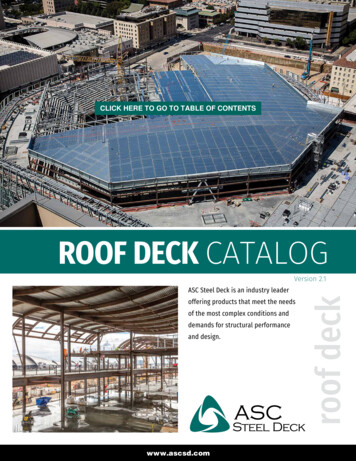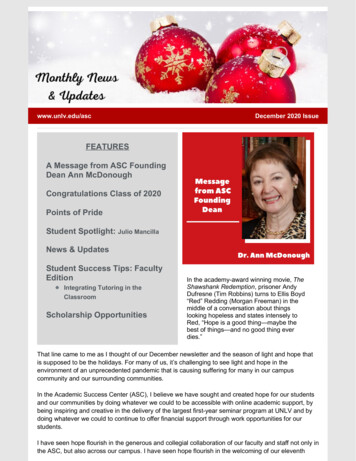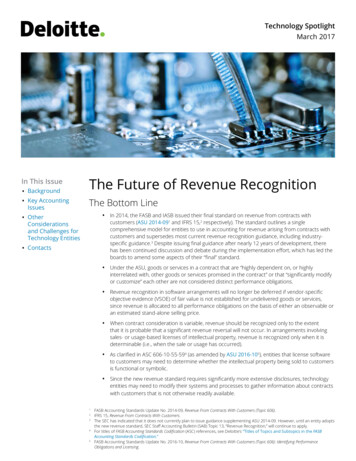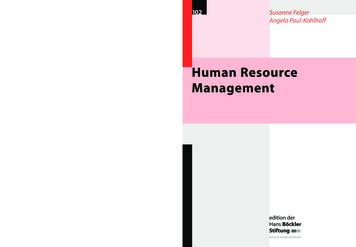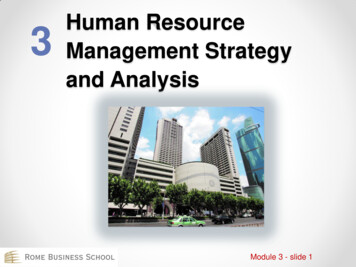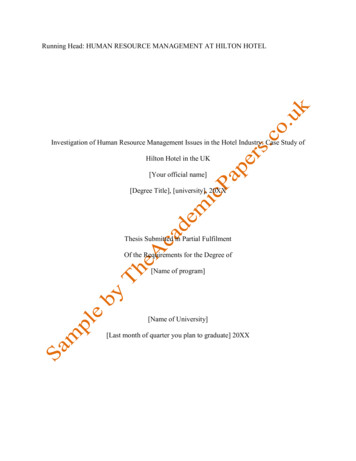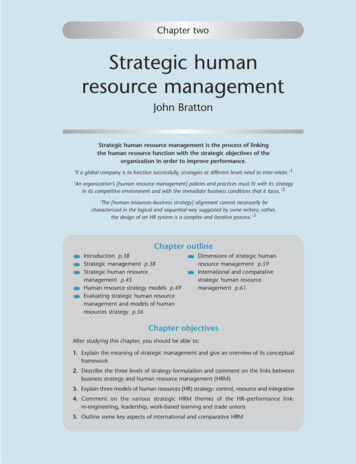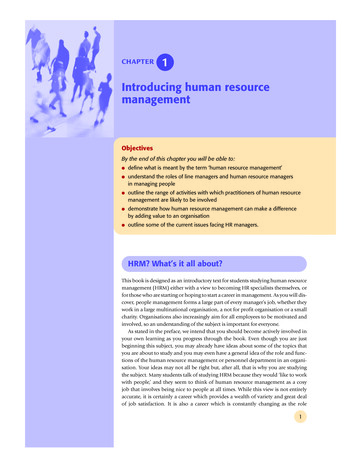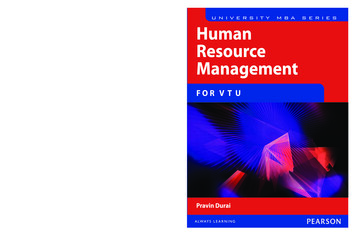
Transcription
HumanResourceManagementPravin DuraiAssociate ProfessorSt Joseph’s College (Autonomous)TiruchirappalliDurai FM.indd i10/17/2011 12:56:21 PM
ToMy ParentsCopyright 2012 Dorling Kindersley (India) Pvt. LtdLicensees of Pearson Education in South AsiaNo part of this eBook may be used or reproduced in any manner whatsoever without the publisher’s priorwritten consent.This eBook may or may not include all assets that were part of the print version. The publisher reserves theright to remove any material present in this eBook at any time.ISBN 9788131767832eISBN 9788131798737Head Office: A-8(A), Sector 62, Knowledge Boulevard, 7th Floor, NOIDA 201 309, IndiaRegistered Office: 11 Local Shopping Centre, Panchsheel Park, New Delhi 110 017, IndiaDurai FM.indd ii10/17/2011 12:56:22 PM
ContentsPrefaceAbout the AuthorPART I HUMAN RESOURCE MANAGEMENT—A CONCEPTUAL FRAMEWORK1Introduction to Human ResourceManagementGoals of Job Analysis4Job DescriptionFeatures of RecruitmentRecruitment Policy858788Steps in the Recruitment ProcessSources of Recruitment539Challenges Affecting the Effectivenessof Job Analysis4143Environmental Influence on the JobDesign44488890Recruitment Practices in India29Critical Components of Job Design8484Recruitment Organization2437Job Specification8384Definitions of Recruitment2379RecruitmentIntroduction22Techniques of Data Collection inJob Analysis32Durai FM.indd iiiFactors Affecting Human ResourcePlanning65Human Resource PlanningProcess67Requirements for Effective HRPlanning78Benefits of HR Planning78Barriers to the HR Planning Process25Job Analysis ProcessJob DesignSignificance of Human ResourcePlanning62Recruitment ProcessImportant Terms in Job Analysis6061Characteristics of Human ResourcePlanning6223Features of Job Analysis55Human Resource PlanningIntroduction22Job Analysis and DesignIntroduction31PART II HR PROCUREMENT54Recent Trends in Job Design1Introduction1Meaning of Human Resources2Uniqueness of Human Resources3Objectives of HRM4Scope of HRM5Functions of HRM6HRM and Personnel Management(PM)10HRM as a Profession11Qualities of an HR Manager13Line Versus Staff Authority of HRM14The Future Role of HRM162Limitations of Job s Between Recruitmentand Selection103Phases of the Selection Process103Employment Application Forms/Blanks105Selection Tests107The Selection Interview112Strategy for an Effective InterviewProcess11510/17/2011 12:56:22 PM
ivCONTENTSAssessing Training NeedsWeaknesses of the InterviewMethod116Reference Checks117Physical Examination117Job Offer118The Selection Process in India6Scope of TrainingSteps in an Employee TrainingProcess164Methods of Training118Design of Evaluation Studies124Issues in TrainingE-learning—An Overview9132133PART III HUMAN RESOURCEDEVELOPMENT140Career Planning and Guidance140140Features of Career Planning10Important Terminology Used in CareerPlanning142144Responsibility for Career Planning andDevelopment148Merits of Career Planning149Limitations of Career Planning151Measures to Improve the Effectiveness ofCareer Planning152Career Guidance8154Employee TrainingIntroductionDurai FM.indd iv158159Significance of Employee Training182COMPENSATION142Process of Career PlanningManagement DevelopmentPART IV HR EVALUATION AND141Objectives of Career Planning176Introduction183Significance of ManagementDevelopment184Goals of ManagementDevelopment184Steps in a Management DevelopmentProcess185Methods of ManagementDevelopment186Evaluation of the DevelopmentProgramme191Management Succession Planning192136Introduction174Conditions Necessary for an EffectiveTraining Programme175Dimensions of OrganizationalSocialization Strategies1357173Effects to be Measured inEvaluation174Differences Between Orientation andSocialization133Placement172Evaluation of a TrainingProgramme172122Introduction123Purpose of Employee OrientationTypes of Orientation125Process of Orientation ProgrammeDevelopment127An Effective OrientationProgramme129Problems in Orientation131The Socialization Process167Audio-visual Aids in TrainingOrientation, Socialization andPlacementSocialization161163159198Performance Evaluation and JobEvaluation198Performance Evaluation: AnIntroduction199Performance Evaluation: AnOverview199Performance Management: AnOverview200Objectives of PerformanceEvaluation200Uses of Performance Evaluation201Determining the Criteria for PerformanceEvaluation204The Process of PerformanceEvaluation20510/17/2011 12:56:22 PM
vCONTENTSSelection of the Evaluator for Conductingthe Performance Evaluation207Performance Evaluation Methods209Issues in Performance Evaluation221Steps to Overcome the Problems in theEvaluation Process223The Post-performance EvaluationInterview: An Overview223Job Evaluation224Characteristics of Job Evaluation225Objectives of Job Evaluation225The Job Evaluation Process225Methods of Job Evaluation227Benefits of Job Evaluation231Limitations of Job Evaluation232Measures to Enhance the Effectiveness ofJob Evaluation23311Compensation AdministrationIntroductionPART V HR MAINTENANCE AND13297Steps in an Employee SafetyProgramme298Need for Employee Safety300Essentials of an Effective SafetyProgramme301Statutory Provisions ConcerningEmployee Safety and Health303Behaviour-based Safety Managementand Approach304Industrial Accidents305Employee Health238Stress14241310311243315Employee Welfare and SocialSecurityIntroductionFactors Influencing Compensation (Wagesand Salary) Administration250Types of Welfare MeasuresSteps in CompensationAdministration254Theories of Employee WelfareChallenges in CompensationAdministration256Limitations of WelfareMeasures331258Social Security267268Objectives of Wage Incentives26815Workers’ Participation andEmpowermentIntroductionPrerequisites for a Good IncentiveScheme271Levels of WPM344WPM Methods344Fringe Benefits290330341342Objectives of WPM274326328342Features of WPMEvaluation of Wage IncentiveSchemes288323332The Wage Incentive PlanningProcess269Types of Incentive Schemes322Employee Welfare ResponsibilityMerits of Welfare MeasuresIncentives and BenefitsIntroduction321Objectives of Employee Welfare246320321Features of Employee Welfare245Executive CompensationDurai FM.indd v296Stress ManagementTheories of Compensation12Employee Well-BeingObjectives for Providing EmployeeSafety297239Types of CompensationPay Structure296IntroductionObjectives of CompensationAdministration239Concept of WagesMOTIVATION343Achieving WPM345Essential Prerequisites forEffective WPM349Significance of WPM35010/17/2011 12:56:22 PM
viCONTENTSObstacles Faced by Effective WPMEmployee Empowerment35216351Job Rotations360Introduction361Characteristics of Promotion361Objectives of Promotion362Criteria for Promotion362Kinds of Promotion365Essentials of a Sound PromotionPolicy366Demotion367Transfer369Employee Separation371PART VI HR INTEGRATION37817378Industrial RelationsIntroduction378Characteristics of IndustrialRelations380Objectives of Industrial Relations380Major Players in IndustrialRelations381Approaches to the Study of IndustrialRelations383Industrial Relations Trends388Factors Influencing IndustrialRelations390Essentials of Effective IndustrialRelations39118Discipline and DisciplinaryActionIntroduction394Characteristics of EmployeeDiscipline395Objectives of Discipline396Types of Discipline398Symptoms and Causes ofIndiscipline402Types of Disciplinary Action406Steps in Establishing a DisciplinaryAction Procedure408Essential Steps to Enhance theEffectiveness of Discipline MeetingsElements of a Good DisciplinarySystem411Durai FM.indd viDouglas McGregor’s Hot Stove Rule ofDiscipline413Code of Discipline41319Employee Grievances417Introduction417Characteristics of Grievances418Sources of Grievance418Techniques of GrievanceIdentification420The Grievance Procedure422Essentials of a Good GrievanceProcedure426Benefits of the Grievance RedressalProcedure427Statutory Provisions Concerning theGrievance Redressal Procedure inIndia428The Model Grievance Procedure428PART VII HR SPECIAL TOPICS20394432Ethical Issues in HumanResource Management432Introduction432Types of Ethics434Ethics and Human ResourceManagement434Need for Ethical Policies and Codes435Approaches to Ethical Issues inOrganizations436Factors Influencing Ethical Behaviour atWork438Role of HRM in the Development ofEthical Behaviour440International Business Ethics443Guidelines for International BusinessOrganizations on Ethical Issues444Ethical Dilemma in Global WagePayment445Miscellaneous Topics448Human Resource Policies448Cost-Benefit Analysis of RecruitmentSources449Employee Mobility450Employee Attrition453410Case Studies457Model Question Papers47510/17/2011 12:56:22 PM
PrefaceDuring the course of my teaching and research career of more than twenty years, I have seen the emergenceof a workforce that is a well-informed, dynamic and diverse entity. To be successful in effectively handlingsuch a workforce, employers, managers and supervisors need to be up to date with the current trends as wellas possess a strong theoretical foundation of human resource practices. The contents of Human ResourceManagement have been developed, therefore, to provide students as well as practicing managers with allinclusive, multifaceted information in a highly readable and understandable form. Besides adopting a userfriendly format, each chapter in the book has several unique real-life examples to support its theoreticaldiscussion and help readers understand the subject matter easily.OrganizationThis book has 20 chapters to enable readers gain complete insights into the different domains of HRM. Basedon the role and responsibilities of HR managers, these chapters are divided into seven parts. The parts andtheir purposes are:Part I—Human Resource Management—A Conceptual Framework familiarizes the reader with theelements of human resource management.Part II—Procurement provides an insight into the topics connected with recruitment, selection and placementof human resources in the organization. Thus, this part includes job analysis, HR planning, recruitment,selection and placement, orientation and socialization.Part III—Development focuses on the topics relating to employee training and management development.The areas of discussion under this part are career planning and development, employee training, management development.Part IV—Evaluation and Compensation comprehensively deals with the core and critical areas of HR management such as employee performance evaluation, compensation administration, and incentives andbenefits management.Part V—Maintenance and Motivation discusses matters relating to employee motivation and retention.This part covers employee well-being, employee welfare and social security, workers’ participation andempowerment, and job rotations.Part VI—Integration offers an insight into the activities that foster employer-employee relations. This partthus includes chapters on industrial relations, discipline and disciplinary action, employee grievance.Part VII—Special Topics discusses in detail the emerging areas of human resource management such asethical issues in human resource management and international human resource management.Miscellaneous Topics discusses assorted topics such as human resource policies, cost-benefit analysis ofrecruitment sources, employee mobility and employee attrition.Each part in this book received equal weightage in terms of treatment and coverage. Thus, the readers willfind an elaborate discussion even on newer areas of human resource management.Durai FM.indd vii10/17/2011 12:56:22 PM
viiiPREFACEThe Teaching and Learning PackageA full range of resources that support teaching and learning is available on the companion Web site of thisbook. PowerPoint lecture slides provide the outlines and key topics of each chapterFeedbackTo share your feedback on this book, readers can write to me at pravindurai@rediffmail.comACKNOWLEDGEMENTSI express my deep sense of gratitude to everyone who helped me in their own way in writing this book.I gratefully acknowledge all institutions like Ashok Leyland, Dorling Kindersley, Infosys, Mind ToolsLimited, the Ministry of Labour of the Government of India, Political and Economic Risk Consultancy, TataServices Limited, the Reserve Bank of India, and Tube Investments of India Limited for their permission touse information pertaining to them in this book. I also thank Ankush Gupta for his permission to utilizeexcerpts from his article in Chapter 19 of this book. Similarly, I am indebted to all the reviewers for theirfeedback and valuable suggestions.I sincerely thank the Jesuit management of St. Joseph’s College (Autonomous), Tiruchirappalli, for providing me with a supportive work environment that enabled me to write this book.I have no words to express my gratitude to my wife, Pramila Pravin, who painstakingly ensured that I wasnot troubled by my family commitments while writing this book. I would like to express my appreciation formy children, Ashwin and Sherine, for their love and affection.Finally, I express my gratitude to Pearson Education for publishing this book. Amarjyoti Dutta and JonakiRay deserve a special mention for their sustained interest and worthy suggestions in the manuscript development. I welcome any critical reviews and feedback from readers, and would consider those as the real rewardfor writing this book.Pravin DuraiDurai FM.indd viii10/17/2011 12:56:22 PM
About the AuthorPravin Durai is Associate Professor, Department of Commerce at St. Joseph’s College(autonomous), Tiruchirappali. He is also a visiting faculty at the Tiruchirappallibranch of Southern India Regional Council of Institute of Chartered Accountants ofIndia (ICAI) and St. Joseph’s Institute of Management, Tiruchirappalli. He is a member of the board of studies for M. Com. Courses at the Bharathidasan University. Heis also a member of the one-man commission of the Bharathidasan University forgranting recognition to M.Phil and PhD programmes of its affiliated colleges. He isthe coordinator of the Micro Quality Assurance Cell (MQAC) at St. Joseph’s College,Tiruchirappalli.Dr Durai has received master’s degrees in commerce and business administration as well as a Ph. D. in organizational behaviour. He has more than twenty years ofteaching and research experience and has published many articles in reputed journals.He has produced three doctorates and over 25 M.Phil Graduates. He has successfully completed a UGC sponsored research project on the problems of HandloomWeavers in TamilNadu. He is one of the authors of a custom book- Management-IIfor Gujarat Technological University (GTU) published by Pearson Education.Durai FM.indd ix10/17/2011 12:56:22 PM
PART I:CHAPTER1Human Resource Management — A Conceptual FrameworkIntroduction to HumanResource ManagementCHAPTER OBJECTIVESAfter reading this chapter, you should be able to:1 Understand the meaning of human resources2 Define the objectives, scope and functions of human resource management (HRM)3 Differentiate between HRM and personnel management4 Enumerate the qualities of HR managers5 Discuss the future role of HRMInfosys Technologies has been adjudged the bestemployer of the year by a number of leadinghuman resource (HR) surveys for its outstanding HR practices. It is one of the few companiesthat succeeded in greatly influencing the attitudeand behaviour of the employees and the performance of the organization through creative HRpractices.The HR policies of Infosys include: (i) focusing on the learnability of candidates in recruitment;(ii) emphasizing continuous learning throughemployee training. For this reason, it has developed a world-class training centre called the GlobalEducation Center at Mysore to train fresh recruitsand an Infosys Leadership Institute to developfuture leaders of the companies; (iii) evaluating theperformance of employees in a scientific mannerthrough a competency-mapping system and(iv) using a variable compensation structure, whichconsiders the collective performance of the individual, the team and the organization as a wholefor fixing the employee-compensation packages.To sum up, its HR philosophy, policy, practices andmanagement have played a pivotal role in makingInfosys a 2billion company today.The success story of Infosys is a proof that HRmanagement (HRM) can be a definite competitiveadvantage for a firm and can make a real differencenot only to the fortune of the organizations but alsoto the individuals as well. Keeping this success storyin mind, let us first learn the basics of HRM in thischapter.IntroductionEvery organization is essentially a combination of physical and human resources (HR). Physicalresources refer to materials, money and machines pre-arranged by the organization for productionor trade. Human resources, on the other hand, refer to the knowledge, education, skills, trainingDurai Chapter 01.indd 110/17/2011 12:38:13 PM
2HUMAN RESOURCE MANAGEMENTand proficiency of the members of the organization. All organizational resources are importantfor achieving the objectives of an organization. In fact, the effectiveness of an organization liesin the judicious blending of the two resources to achieve optimum competency.However, for a long time, it was felt that the efficient utilization of physical resourceswas primary for developing an organization. This was so because the acquisition of physicalresources resulted in a huge outflow of funds and those assets carried a definite value. On thecontrary, it was felt that hiring employees never cost anything substantial for a firm and it wasalso quite easy to replace them. This made human resources less important for employers.But, in the past decade, employers have realized that intellectual capital is critical to businesssuccess. The main reasons for this change are due to the understanding that1. Product innovation and marketing strategy, which are crucial for market survival andgrowth in a competitive environment, are possible only when a good and creativeworkforce is present.2. The challenge, opportunities and even disputes of creating and managing organizations arise mostly from people-centred problems.3. People are not alike and they cannot be treated identically. They differ physically andpsychologically. These differences require individual attention in order to achieve theoptimum productivity.Indian organizations are no exception to this change in understanding. They realize that technology by itself cannot triumph in the market and that technology coupled with a workforceis essential for the success of an organization. The growing importance of HR in Indian organizations is best reflected in their mission statements. The mission statements of a few Indianorganizations, which emphasize the significance of human resources, are presented in Table 1.1.Meaning of Human ResourcesOrganizations are managed by people and through people. Without people, organizations cannever exist. Indeed, people who make up the human resources of a company are unique andthey can make or break an organization, depending upon their level of commitment, contribution and cooperation. Hence, it is relevant to know the intricacies of the term human resourcesfirst, before we discuss HR management (HRM) in detail. Different people have defined humanresources differently. Box 1.1 showcases the various definitions of human resources.Table 1.1 Mission Statements of a Few OrganizationsTo develop ICICI Bank into an organization that is empowered by bright and talented individuals, working in teams and riding on the backbone of world-class technology.–ICICI BANKTo be a globally respected corporation that provides the best-of-breed business solutions leveragingtechnology delivered by the best-in-class people.–INFOSYSTo deliver superior value to our customers, shareholders, employees, and society at large.–ADITYA BIRLA GROUPTo ensure anywhere and anytime banking for the customer with the latest state-of-the-art technologyand by developing effective customer-centric relationships and to emerge as a world-class service provider through efficient utilization of human resources and product innovation.– ALLAHABAD BANKDurai Chapter 01.indd 210/17/2011 12:38:13 PM
INTRODUCTION TO HUMAN RESOURCE MANAGEMENTBox1.13Definitions of human resourcesHuman resources are “a whole consisting of inter-related,inter-dependent and interacting physiological, psychological, sociological and ethical components.”1–Michael J. Jucius“From the national point of view, human resources areknowledge, skills and attitude obtained in the population;while for individual enterprises, they represent the totalof the abilities, knowledge and skills of its employees.”2–Leon C. MegginsonWe would define human resources as the collection of people and their characteristics atwork. These are distinct and unique to an organization in several ways.Uniqueness of Human ResourcesThe distinct features of human resources are:1. Human resources are the only assets that appreciate over a period while physicalresources just depreciate with years.2. Further, human resources alone can produce an output larger than the input. This ispossible due to the creative skills of humans. Creative thinking is the process of predicting, envisioning and then inventing an idea, concept or insight along innovativeand alternative lines. People in the organization are the only basis for such creativityand there is no obvious limit to their imagination.3. Organizations require human resources of different types to operate all physicalresources. Thus, they provide utility value to each one of the physical assets. In fact, thereal worth of a physical asset depends on the quality and calibre of the people workingwith it. An incompetent workforce will spoil the physical resources available to it.4. There is a growing realization that the flexibility of an organization depends more onpeople than on any technical factors. Modern equipment may ensure quality and costcompetitiveness but the operational flexibility, which is core to product modificationand innovation, is provided only by the employees. This is so since humans alone couldgrasp the situation adequately and respond suitably.The effective utilization of human resources is a complex task. It requires greater foresight and strategic consideration on the part of the management. For instance, attractingthe most qualified employees, matching them to the jobs for which they are best suited andretaining them within the organization are significant for the success of an organization.But this calls for closer coordination and better understanding between the employers andthe employees. However, many enterprises are too large to permit close contact betweenthe top management and the employees. This is where HR managers act as a crucial linkbetween the management and the employees.HRM, as a field of study, makes a sincere effort to provide knowledge, skills and abilityfor managing human resources more effectively. The basic task of HRM is the selection of theright person for the right job at the right time to carry out the activities of an organizationin the most efficient way. It also aims to enhance the satisfaction, morale and productivityof employees, control labour turnover, and help organizations increase their performance byproviding the necessary training and development opportunities, suitable working conditionsand appropriate career growth to employees.Durai Chapter 01.indd 310/17/2011 12:38:13 PM
4HUMAN RESOURCE MANAGEMENTBox1.2Definitions of HRM“Personnel management, or say human resource management, is the planning, organizing, directing andcontrolling of the procurement, development, compensation, integration, maintenance and separation ofhuman resources to the end that individual, organizational and social objectives are accomplished.”3–Edwin B. Flippo“Personnel management is that part of management (whichis) concerned with people at work and with their relationships within an enterprise. Its aim is to bring together anddevelop into an effective organization the men and womenwho make up an enterprise and, having regard for the wellbeing of the individual and of working groups, to enablethem to make their best contribution to its success.”4–Institute of Personnel Management (IPM)“Human resource management is concerned with thepeople dimension in management. Since every organization is made up of people, acquiring their services,developing their skills, motivating them to higher levelsof performance and ensuring that they continue to maintain their commitment to the organization are essential toachieving organizational objectives. This is true, regardless of the type of organization—government, business,education, health, recreation, or social action.”5–David A. Decenzo and Stephen P. Robbins“Human resource management is a series of integrateddecisions that form the employment relationship; theirquality contributes to the ability of the organizations andthe employees to achieve their objectives.”6–George T. Milkovich and John W. BoudreauThough different authors have defined HRM differently, they have all emphasized theeffective utilization of the workforce for accomplishing the organizational and individualgoals and objectives. Some of these definitions of HRM are mentioned in Box 1.2.To sum up, we can say that HRM is concerned with policies and practices that ensure thebest use of the human resources for fulfilling the organizational and individual goals.Objectives of HRMThe primary objective of HRM is to take care of the work life of the employees from the timethey join the organization to the time they leave it, while ensuring their best possible cooperation in achieving the organizational goals and objectives. This broad objective of HRMcan be classified into the following specific ones:1. To act as a liaison between the top management and the employees2. To arrange and maintain adequate manpower inventory, which, in turn, ensures thesmooth working of the organization3. To offer training as a way of developing skills, enhancing productivity and, most importantly, increasing individual and organizational performance to achieve the desiredresults4. To devise employee benefit schemes for improving employee motivation and groupmorale and enhancing employer–employee cooperation5. To ensure and enhance the quality of work life, which refers to the employees’ perception oftheir physical and psychological well-being at work6. To help keep up ethical values and behaviour amongst employees both within andoutside the organizationBox 1.3 describes the HR objectives of the Tata group.Durai Chapter 01.indd 410/17/2011 12:38:13 PM
5INTRODUCTION TO HUMAN RESOURCE MANAGEMENTBox1.3HR Objectives of the Tata GroupA Tata company shall provide equal opportunities to allits employees and all qualified applicants for employment without regard to their race, caste, religion, colour,ancestry, marital status, gender, sexual orientation, age,nationality, ethnic origin or disability.HR policies shall promote diversity and equality inthe workplace as well as compliance with all local labourlaws, while encouraging the adoption of the best international practices.Employees of a Tata company shall be treated withdignity and in accordance with the Tata policy ofmaintaining a work environment free of all forms ofharassment, whether physical, verbal or psychological.Employee policies and practices shall be administeredin a manner consistent with the applicable laws and theother provisions of this code, respect for the right to privacy and the right to be heard, and that in all mattersequal opportunity is provided to those eligible and thatdecisions are based on merit.Adapted from: cope of HRMThe scope of HRM is extensive and exhaustive. An understanding of HRM is important toanyone who is employed in an organization. HR issues become important wherever there is agroup of workers. Staffing is performed by all the managers as a managerial function, eitherdirectly or indirectly through the HR department. All managers are, in this way, HR managerssince they get involved in HR activities like choosing, training, inducting, compensating andmotivating the employees along with industrial relations activities. Thus, they must understand the scope and application of the personnel policies of their organization in order toensure that their everyday personnel actions are consistent with those policies as any violationof such policies may get them into confrontations with their subordinates.Further, knowledge of the basics of HRM is important even to non-managerial employees as they may be keen to know the impact of the personnel policies of their organization ontheir own compensation, training and career growth aspects. Thus, the personnel aspects ofmanagement run through the entire organization.The Institute of Personnel Management (IPM)7 has mentioned the scope of HRM asfollows:Personnel or Labour Aspect The first aspect deals with manpower planning, recruitment, selection, placement, transfer, promotion, training and development, lay-offs andretrenchment, remuneration, incentives and productivity.Welfare Aspect This aspect is concerned with the working conditions and with amenitiessuch as canteen, crèches, rest- and lunch-rooms, housing, transport, medical assistance, education, health and safety, and recreation facilities.Industrial Relations Aspect This aspect pertains to union–management relations,joint consultations, collective bargaining, grievance and disciplinary actions, and settlementof disputes.In the last decade, there has been a realization amongst managers that good plans, effectiveorganizational structures, impressive plants and modern technologies may not guarantee thesuccess of the organization unless they hire the right persons, train them suitably, appraise themproperly, and constantly motivate them
ethical issues in human resource management and international human resource management. Miscellaneous Topics discusses assorted topics such as human resource policies, cost-benefi t analysis of recruitment sources, employee mobility and employee attrition. Each part in this book received equal weightage in terms of treatment and coverage. Th .


